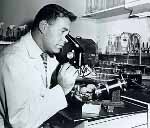 | ||||||
|
With men just back from war and the nation recovering from the Great Depression, Americans commenced a baby boom. Birthrates rose for virtually every racial and income group in the country. While the baby boom certainly reflected a new sense of economic prosperity, historian Elaine Tyler May says there was also a sense of "patriotic parenthood" at work. Babies had become a badge of citizenship for white, middle-class Americans.
Couples whose infertility eluded diagnosis were sometimes screened for psychological problems. May says that the 1950s "witnessed a romance with all forms of psychology." Women were scrutinized to determine whether they were too neurotic to become pregnant -- some were suspected of being emotionally cold and un-motherly. Psychologists theorized that infertile men subconsciously resisted their masculinity or just didn't want children. Part seven: "Child-Free" |


